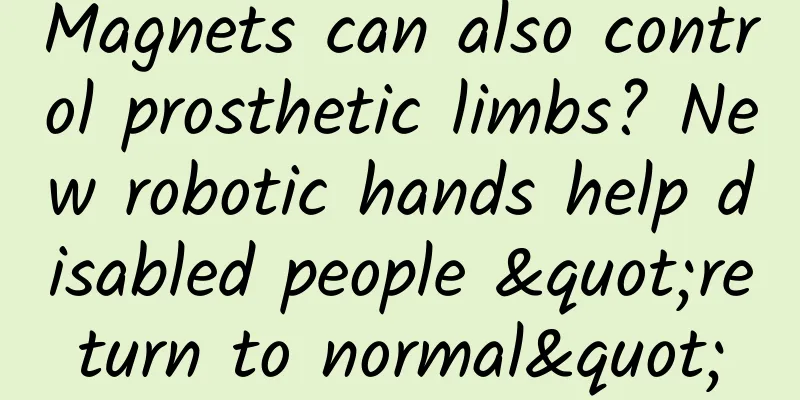Magnets can also control prosthetic limbs? New robotic hands help disabled people "return to normal"

|
Tuchong Creative Recently, a team from the Biorobotics Institute of the Sant'Anna University in Pisa, Italy, developed a new robotic hand that allows patients to manipulate it like their own hands. And this robotic hand has been successfully tested on a patient. Some friends asked, can this prosthetic hand really be used like a real hand? We have talked about brain-computer interface before. We have talked about brain-computer interface in our previous program. Friends who are interested can go and watch it. In simple terms, brain-computer interface is to implant electrodes in the patient's brain to collect electrical signals to analyze what he is thinking, and then transmit the signals to the installed manipulator or other mechanical device to achieve operations such as writing and walking. But this time it is not a brain-computer interface. After all, brain-computer interfaces are relatively complex, and currently implantation is difficult and risky. If this new robotic arm is analogous to a brain-computer interface, it should be called an "arm-machine interface," which is to install a "socket" in the residual arm of an amputee. What does it mean? Although amputee patients have lost their hands, the remaining muscles in their forearms are still controlled by the brain as before and move according to the brain's instructions. The movement of these residual muscles will reflect the person's movement intention. In other words, before the amputation, the patient would grab whatever he wanted with his hands. After the amputation, when he wants to grab something, although his hands are gone, the residual muscles will still move as before. This new robot arm detects and analyzes the movement of these residual muscles, transmits their "movement intention" signals to the robot arm, and allows the robot arm to execute. How to control it specifically? The research team used a micro magnet of about a few millimeters in size and implanted it into the residual muscle of the amputated arm. When the muscle moves, the magnet moves with it, and the magnetic field in the space changes. Then, through a special algorithm, this change is converted into instructions for the robot. Compared with brain-computer interface, this technology is simpler and safer because there is no need to implant electrodes in the brain. In fact, there are many studies on this kind of prosthesis, all of which aim to directly control the movement of the joints of the hand through the muscles of the stump. How are they controlled? Because the only signal source that can be used here is basically muscle, so a large part of it uses the electrical signal generated by the muscle, which we also call electromyographic signal. But there is a disadvantage in using electromyographic signal, which is that it is very easy to be interfered by external signals. When I was studying for my doctorate, I did a research that required measuring the electromyographic signal of rats. It was very difficult and there was a lot of interference. The research we are talking about this time did not use electromyographic signals, but another method, which was to utilize the movement, contraction and relaxation of muscles, and then the position of the muscle stump moved. However, this actually has its difficulties, that is, quantitative measurement is very difficult. Therefore, it was particularly not easy for them to succeed in using a magnet. Moreover, although their research also looks like a robot, it is also very different from the traditional robot. Many of our friends have seen science fiction movies, and many science and technology museums have related displays. The robot can remotely control the mechanical arm and perform various operations, but traditional robots are generally not designed for people with disabilities. Many of them are operated by people through buttons or joysticks. But this research is different, this robot hand is used as a "real hand" for disabled people. And it does not mean that disabled people can control it indirectly through voice control or other channels, but it can point and hit just like a normal hand, which is amazing. The research team tested the prosthesis on patients for 6 weeks. The patients were able to pick up and move objects of different shapes relatively easily, such as pouring water, opening cans, using screwdrivers, cutting with knives, and zipping. They could also control the strength with which they grasped fragile objects. This research result can be said to be a major advancement in the field of prosthetic science, and is a cutting-edge exploration conducted by scientists to change the future development of prosthetics. Therefore, the development of science and technology has also solved problems for more and more disabled people. By using science and technology to help disabled people, we hope that they can live a normal life like normal people, and even play the piano with this mechanical hand in the future, just like some athletes who use prosthetic limbs to participate in normal competitions. I don't know if you all still remember that in the 2008 Beijing Olympics, there was an athlete called Blade Warrior, Pistorius, a disabled person without calves. He had won the championship in the Paralympics a long time ago. In 2008, he used prosthetic limbs to participate in the Olympics for normal people and also won a certain ranking. It was indeed very difficult for this athlete, Blade Warrior, but many scientists opposed his participation in the competition at that time. Why? There are indeed some ethical risks. Think about it, if mechanical prosthetic devices really replace the original organs of the human body, if they can still achieve good results, in other words, if people can improve their performance with the help of mechanical devices, it is possible that some people will work hard in this direction. Let's look at Mr. Jin Yong's novel "The Sword of Blood and Plum Blossom", the leader of the Five Poisons, He Tieshou, who cut off his hand to practice martial arts and replaced it with an iron hook. There are also many science fiction movies with cyborgs, where some parts of the human body are replaced by machines. Including some people who have good teeth but don't use them, but insist on replacing them with gold teeth. So in fact, we say that many scientific and technological achievements have two sides. If they are used well, they will benefit people. If they are not used well, scientific and ethical issues will easily arise. If the science of prosthetics develops very rapidly in the future, and the prosthetics made are better than real ones and have more functions, then we may really need to solve some scientific and ethical issues. But then again, our current related technology has not yet developed to that level, and there is no need to worry too much at present, so this research is of great significance to humans, especially some special groups. This article is a work supported by the Science Popularization China Creation Cultivation Program Author: Zhang Yuzhi Reviewer: Liu Zhicheng Dean/Professor, School of Biomedical Engineering, Capital Medical University Produced by: China Association for Science and Technology Department of Science Popularization Producer: China Science and Technology Press Co., Ltd., Beijing Zhongke Xinghe Culture Media Co., Ltd. |
Recommend
TSMC needs the mainland market to break Samsung's game
Since TSMC lost to Samsung in the 14/16nm FinFET ...
Rules for creating popular short videos on Tik Tok!
The article summarizes 36 rules for creating popu...
Latest data! 34 new confirmed cases in 31 provinces, autonomous regions and municipalities, no new confirmed cases in Hubei
From 0:00 to 24:00 on March 18, 31 provinces (aut...
Summary of issues regarding live broadcast advertising
【Q1】 We are engaged in direct investment in funct...
Huawei App Market Paid Promotion Operation Guide!
1. Developer Registration First, you need to regi...
Four-dimensional quadrant method to analyze Baidu bidding keywords
We organize all the keywords in the account and c...
How to choose channels for app soft promotion?
There is another big pitfall in App soft promotio...
The Seventh Tik Tok Marketing Course of Red Planet
This Red Planet course is taught by teacher Xue H...
News app finally appears in iOS 9 Beta 3 hands-on testing
Apple released its next-generation operating syst...
How to turn demand into practical product solutions!
Here we assume that the company already has a cer...
There are 360 days in a year. Eating lychees every day is not a dream.
What would it be like to sequence the lychee geno...
Apple releases OS X Yosemite beta 5, continues to optimize Photos app
[[130368]] Apple today released the fifth beta of...
How to make money by posting videos on Xigua Video? How to make money by shooting Xigua videos?
There are many mobile phone apps on the Internet ...
Is the "silver needle test for poison" in TV dramas real? Just for entertainment, don't take it seriously!
In ancient times, there was a common method of te...
The legendary "Ice Tribe Divine Stone" in the web drama has been used by scientists to create a new world
Recently, the web drama "The Great Dream Ret...









